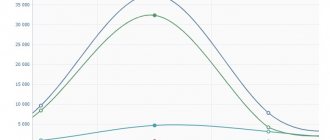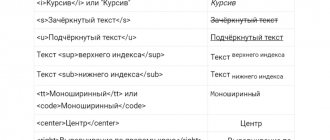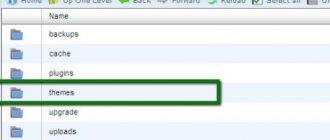Definition
Viral reach is the number of people who saw the community’s content and are not its subscribers.
Subscriber and advertising reach are also distinguished. We can look at the latter if we use the services of the exchange or the VKontakte Advertising Network.
Total reach is the total number of people who saw the posts of your personal page or group. This includes followers, friends and other VK users.
If we subtract advertising from the full coverage, we get organic, that is, these are people who came to our community on their own. This includes subscribers and new visitors.
From time to time, some indicators appear or disappear in the statistics, the interface and algorithms of the social network change. But in general, the essence remains the same: traffic is divided into sources for further study, analysis and work to increase it, which is what all owners of groups and publics are interested in.
How to find out your indicators
We have already talked in detail about how to view the statistics of personal and public VKontakte pages, and what each indicator means. Now I will only show you how to find out the coverage.
Go to the “Communities” section in the left menu.
Then switch to the “Management” tab. Statistics are only available if we have administrator rights, or this information is open to public viewing, which is very rare. Typically, the owners of groups and public sites do not seek to advertise their statistics.
Open the community we need and find the desired section in the menu on the right.
Switch to the “Reach” tab and see your results. Below the graph you can enable or disable individual indicators. If you hover your mouse over the graph, you will see the number of people in numerical terms at each vertex.
Reach on Instagram
Instagram is owned by Facebook, so these platforms have similar algorithms for ranking posts in their feed.
And yet, what is reach on Instagram and what influences it? Reach is unique views of a post, 1 account gives 1 view. Audience coverage on Instagram is affected by the time of publication of a post, the speed of gaining likes and comments, saving a post, correspondence in direct messages with an account, and switching to an account from a search.
How to see reach on Instagram?
We figured out what reach is on Instagram, now you need to find out how to view reach. Instagram statistics (available only for business accounts) shows the profile's reach over the last 7 days:
And the coverage of each publication:
Why know viral reach?
We need different types of data for analysis and further promotion of a group or community. When we launch an advertising campaign, we set certain goals and see whether we achieved them or not, and analyze the results. These are standard actions, but analysis of viral coverage is carried out quite rarely. And in my opinion, in vain.
If we are interested in promoting and expanding our audience, then it is important to understand how many new people see our VKontakte posts, because new visitors can become subscribers, our regular readers, and then buyers if we are talking about a commercial project.
Viral reach tells us primarily about the quality of content; this is how it differs from other indicators. You can order advertising, increase views and likes, but if the publications on the page do not interest anyone, people do not subscribe to the news and do not join the group, then all these actions and money will be wasted.
The word “viral” comes from the English “viral”, which means “viral”. You've probably heard the expression “viral content”. These are texts, pictures and videos that people are happy to share with each other. When your subscriber reposted a community post, his friends saw it, shared it on their pages, and so on down the chain, then this is viral content. And the result that we see in the statistics is an increase in viral coverage.
One good post can bring a serious influx of visitors and an increase in the number of subscribers. Moreover, this method of promotion can be considered conditionally free, but this does not mean that it is simple. You need to try hard to ensure that the content hooks the users of the social network and brings the target audience to you, and not just the curious or lovers of freebies.
From vertical coverage to detachments
From vertical coverage to detachments
The KPA special operations forces are an interspecific branch of the KPA troops, designed to conduct reconnaissance, sabotage and air assault operations in the operational and tactical (military) rear of the enemy in the interests of the Supreme High Command itself, as well as the commands of the branches of the armed forces and formations (corps, divisions) ground forces. Already in peacetime, North Korean special forces participate in reconnaissance and sabotage operations against South Korea - its small units are dropped into enemy territory by sea (including small and midget submarines), air and land (using secret tunnels dug in the demilitarized zone).
The range of combat missions assigned to KPA special operations forces includes:
a) capture or destruction of enemy military facilities with nuclear and other types of weapons of mass destruction;
b) capture or destruction of important objects of the enemy’s military and civilian infrastructure (control points, nodes and communication lines, airfields, railway junctions, ports, power plants, dams, bridges, tunnels, etc.);
c) penetration into the depths of the enemy’s defense and rear 35–70 km from the front line with the aim of disorganizing them;
d) vertical coverage and attacks on the enemy’s flanks in order to ensure the development of the offensive of formations and units of ground forces;
e) conducting in-depth reconnaissance in the interests of corps and divisions of ground forces;
f) deployment of partisan actions on enemy territory by forming partisan detachments from local residents under one’s control;
g) actions to protect one’s rear as barriers against the penetration of enemy reconnaissance and sabotage units;
h) acting as barrage detachments to prevent the escape and desertion of KPA military personnel who have left the subordination of their command.
The North Korean military command began creating and deploying special forces in the 1960s, and already in 1969 the 7th Special Forces Corps was deployed, which included 14 light infantry brigades, and another 8 of the same brigades were deployed in composition of combined arms corps of forward echelons. By 1988, the KPA special forces had eight airborne brigades - 30 thousand people, 4 reconnaissance brigades - 16.8 thousand people, 3 amphibious landing brigades (marines) - 9 thousand people and 44 separate light infantry battalions - 48.2 thousand people.
Currently, the KPA special operations forces have a dual subordination, being under the jurisdiction of the “light infantry training management bureau” (that is, the special operations forces command itself) and the intelligence department of the General Staff (RUGS). By 2010, with a total number of 88 thousand people, they included the following formations and units:
– 6 sniper brigades (attached to ground forces);
– 2 naval sniper brigades (attached to the Navy);
– 2 airborne sniper brigades;
– 3 airborne brigades;
– 12 (according to other sources – 9) light infantry brigades (part of the combined arms corps);
– 17 separate reconnaissance battalions;
– 8 separate special purpose battalions (directly subordinate to the RUGS);
- separate special purpose parachute battalion.
In addition, the KPA combined arms formations (corps and divisions) have separate light infantry battalions.
The “Light Infantry Training Management Bureau” carries out general administrative management of special operations forces and organizes their combat and tactical-special training, and in wartime, in cooperation with the commands of the armed forces, is responsible for conducting airmobile, airborne and amphibious operations, including coordinating the use of light infantry formations and units that are part of combined arms corps and divisions. The RUGS concentrates its management efforts on conducting reconnaissance and sabotage operations deep in enemy territory and organizing partisan actions there, as well as on managing the intelligence apparatus previously deployed in South Korea and its interaction with military sabotage and reconnaissance groups.
Of the six sniper brigades (analogues of the special forces brigades of the Main Intelligence Directorate of the General Staff of the Armed Forces of the USSR and Russia), four are deployed in forward areas adjacent to the demilitarized zone in Gangwon Province and in the territory of Kaesong Municipality. One of these brigades (according to some sources, it bears the poetic name “Peony”) is staffed entirely by female soldiers. The sniper brigade consists of a headquarters company, 10 sniper battalions, an assault company, a communications company and support and logistics units, and a sniper battalion consists of a headquarters platoon, 5 sniper companies, a communications platoon and support units.
They differ from light infantry brigades that are part of combined arms corps (the organizational structure of these brigades is shown in Table 11) in that the former usually conduct combat operations in close cooperation with tank, motorized infantry and infantry formations and units as a whole or in the battalion-level. company" (including in the usual "infantry" capacity), while sniper brigades are used independently and "in bulk", as part of small reconnaissance and sabotage groups no more than a platoon and a squad. Both of them have air mobility limited by the existing fleet of helicopters.
The same difference is between airborne (intended for use in tactical parachute and helicopter landings) and airborne sniper brigades (used in special operations and operating in small combat groups). Both airborne sniper brigades are stationed in the provinces of Gangwon-do and Hwanghae-buk-do.
Naval sniper brigades are deployed on the coasts of the Yellow and Sea of Japan - one for each of the North Korean fleets (Western and East). This is the North Korean marine corps, combining the performance of its inherent combat missions (amphibious landing operations) with the functions of detachments of “classic” combat swimmers. Marine sniper brigades are assigned 102 landing boats (including hovercraft) from the KPA Navy.
Already in peacetime, they are involved in actions against South Korea, secretly landing their sabotage and reconnaissance groups on its coast. The main unit of such a brigade is a naval sniper battalion of about 400 people consisting of a headquarters company, five companies of naval snipers (some of them are combat swimmers with light diving training), a communications platoon and support units. Each brigade can have up to 10 such battalions.
In wartime, in addition to performing special combat missions to destroy enemy ships and vessels, capture and destroy its important naval and other coastal facilities, North Korean “frog people” will be, depending on the assigned tasks, like the first (airborne assault) ) the echelon of amphibious operations, and, together with other special forces forces, the backbone of the amphibious assault force. As suggested by the American and South Korean headquarters, the KPA is capable of landing up to 7 thousand special forces soldiers on the western and eastern coasts of South Korea, of which up to 5 thousand in one wave aboard landing ships and boats of the KPA Navy.
Separate reconnaissance battalions are designed to conduct in-depth reconnaissance behind enemy lines in the front line, simultaneously carrying out tasks to destroy important objects discovered there. Special purpose battalions of the RUGS are “sharpened” to carry out particularly important “targeted surgical” combat missions in the operational and even strategic rear of the enemy and to deploy a partisan movement on its territory with the involvement of the local population (in cooperation with the agents operating there).
The idea of deploying a partisan movement on the territory of South Korea is not new - it was already implemented with greater or lesser success during the war of 1950 - 1953. However, it is not very clear which contingent of future partisans from the local population of quite prosperous South Korea the military command of the totalitarian and impoverished North Korea can rely on today. It is known that South Korean citizens, on the contrary, willingly help the security forces and army of their state to catch North Korean reconnaissance saboteurs who periodically visit their neighbors.
Be that as it may, in the event of war, it is the KPA special forces that, in Pyongyang’s opinion, should form the initial professional backbone of the partisan detachments behind enemy lines. Having put together such a detachment (from a platoon to a regiment), the military personnel must return to their point of deployment, and the partisans must continue independent military operations and sabotage against “American imperialism and its puppets.”
How to increase the influx of new visitors
This question is asked by almost all owners and administrators of open groups and publics: from beginners to advanced Internet marketers. Of course, in each individual case the recommendations will be individual. But there are also general tips for creating interesting and useful content that will be distributed across the network without your further participation:
- Write small, clear instructions, cases, checklists.
- Make lists of books, movies, recipes, ideas, and anything else that somehow relates to your community.
- Use different types of content: video, audio, images, infographics, diagrams, tables, Stories, live broadcasts.
- Involve users, conduct competitions, surveys, quests and other interesting activities.
- Use modern trends, popular films, TV series and music. Think about how much varied content designers and marketers have created that mention Game of Thrones characters and events.
- Whenever possible, make jokes and produce entertaining and humorous content. This is perhaps the most replicated product after cases and useful lists, and maybe even ahead of them.
- Capture emotions, take into account the aspirations, interests and pains of your target audience, think like them. For example, go to popular communities for moms. Yes, there is useful content, but there are a lot of emotional messages about how mothers get tired with their kids, how children talk and behave in different situations.
- Surprise, come up with interesting scenarios for videos, practical jokes, puzzles.
- Encourage the creation of user-generated content, reviews, Stories, photos. Subscribers will definitely share such materials with their friends.
- Talk about important things: health, ecology, laws, love, relationships.
- Share interesting and important news that is not covered in the media.
- Tell stories: real and fictional, this is one of the most in-demand types of content today.
- Encourage the distribution of community materials and the most active users, tag the best comments, ask for captions for publications.
- Team up with other administrators and bloggers to create joint marathons, broadcasts and publications. This technique is widely used on Instagram, but it can also be effectively used on VK.
- To increase activity in the group, you can increase views, likes and reposts. When a person sees that a post has already received a lot of responses from other users, he is more willing to pay attention to it. But do not overuse such events, do everything wisely.
And the last tip for today: don’t forget about design. Your posts should stand out and attract attention. To do this, you can use bright colors or, conversely, a monochrome palette, if appropriate. The text should be easy to read, and the picture should arouse interest and intrigue. We only have a few seconds to grab the attention of a user scrolling through a social media feed. If this succeeds, then we are halfway to success.










